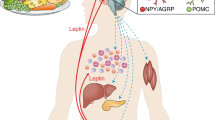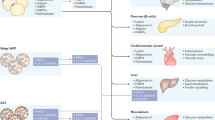Abstract
The discovery of leptin has imparted great impetus to adipose tissue research by demonstrating a more active role for the adipocyte in energy regulation. Besides leptin, however, the adipose tissue also secretes a large number other signals. Cytokine signals, TNFα and IL-6, and components of the alternative pathway of complement influence peripheral fuel storage, mobilization and combustion, as well as energy homeostasis. In addition to the acute regulation of fuel metabolism, adipose tissue also influences steroid conversion and sexual maturation. In this way, adipose tissue is an active endocrine organ, influencing many aspects of fuel metabolism through a network of local and systemic signals, which interact with the established neuroendocrine regulators of adipose tissue. Thus, insulin, catecholamines and anterior pituitary endocrine axes interact at multiple levels with both cytokines and leptin. It may be proposed that the existence of this network of adipose tissue signalling pathways, arranged in an hierarchical fashion, constitutes a metabolic repertoire which enables the organism to adapt to a range of different metabolic challenges, including starvation, reproduction, times of physical activity, stress and infection, as well as short periods of gross energy excess. However, the occurrence of more prolonged periods of energy surplus, leading to obesity, is an unusual state in evolutionary terms, and the adipose tissue signalling repertoire, although sophisticated, adapts poorly to these conditions. Rather, the responses of the adipose tissue endocrine network to obesity are maladaptive, and lay the foundations of metabolic disease.
This is a preview of subscription content, access via your institution
Access options
Subscribe to this journal
Receive 12 print issues and online access
$259.00 per year
only $21.58 per issue
Buy this article
- Purchase on Springer Link
- Instant access to full article PDF
Prices may be subject to local taxes which are calculated during checkout
Similar content being viewed by others
Author information
Authors and Affiliations
Rights and permissions
About this article
Cite this article
Mohamed-Ali, V., Pinkney, J. & Coppack, S. Adipose tissue as an endocrine and paracrine organ. Int J Obes 22, 1145–1158 (1998). https://doi.org/10.1038/sj.ijo.0800770
Received:
Revised:
Accepted:
Published:
Issue Date:
DOI: https://doi.org/10.1038/sj.ijo.0800770
Keywords
This article is cited by
-
HMGB1 mediates microbiome-immune axis dysregulation underlying reduced neutralization capacity in obesity-related post-acute sequelae of SARS-CoV-2
Scientific Reports (2024)
-
Role of HOMA-IR and IL-6 as screening markers for the metabolic syndrome in patients with chronic schizophrenia: a psychiatric hospital-based cross-sectional study
European Archives of Psychiatry and Clinical Neuroscience (2023)
-
Living Electrospun Short Fibrous Sponge via Engineered Nanofat for Wound Healing
Advanced Fiber Materials (2023)
-
Position statement on nutrition therapy for overweight and obesity: nutrition department of the Brazilian association for the study of obesity and metabolic syndrome (ABESO—2022)
Diabetology & Metabolic Syndrome (2023)
-
A longitudinal analysis of serum adiponectin levels and bone mineral density in postmenopausal women in Taiwan
Scientific Reports (2022)



